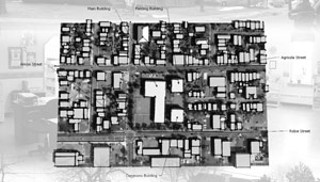HRM staff and consultant Brian Mackay Lyons will present a master plan for the redevelopment of the Bloomfield Centre site at a public open house Thursday, December 4. A draft of the plan in circulation last week outlines three considered options, including the renovation of the current centre. But the plan ultimately recommends demolishing the ’70s-era Bloomfield School building in favour of a complete redesign of the site, allowing for higher density residential and commercial development.
The draft plan sketches out rows of townhouses along Agricola and Robie and two residential/commercial towers (10 and 15 storeys) at the Almon corners of the site. The historic Fielding and Commons buildings would remain, but the Bloomfield School building would be replaced by two new smaller buildings for public arts and cultural uses. The proposal re-establishes Bloomfield Lane (from Agricola to Robie) and Fern Lane (from May to Almon) as corridors for pedestrians and local traffic. Affordable housing is also included, aimed at families with household incomes starting at $32,000 per year.
The inclusion of community spaces in the plan reflects a change of heart by city staff and council who, for years, have been working towards closing down the Bloomfield Centre by evicting tenants and not offering new or renewed leases on spaces in the buildings. (Only seven tenants remain today of the 54 that occupied the centre in 2004.)
“We’re really happy that the city has gotten a consultant to do a master plan,” says Susanna Fuller, co-chair of Imagine Bloomfield, the community organization formed in response to the potential closure of the Bloomfield Centre in 2004. “However, there are some things missing and some of those we think are key elements.”
Fuller cites a lack of focus on green building technologies, as well as too narrow a focus on arts and cultural programming. Another concern is the financial model proposed in the master plan. The city aims to have Bloomfield pay for itself, avoiding municipal funding for construction or future operation of the facilities. The master plan looks at achieving this solely through revenue from private development and property tax revenues. “That’s not a very innovative financial model,” says Fuller.
Fuller thinks the project can access federal funding for heritage and green buildings plus provincial funding for social and affordable housing. She also suggests creating a sense of community ownership by including the centre’s potential not-for-profit tenants in the financial planning. “Some non-profits do have money to put into new spaces. Usually they don’t have enough to buy their own place, but if it’s properly designed, several non-profits can pull together resources and contribute to renovating or building a new space.”
HRM staffer Holly Richardson hasn’t ruled out potential partnerships with community groups. “That’s an example of another piece of work and exploration that we need to do,” says Richardson. “The details of how those numbers work may change as we start to engage with the community and are able to find a really solid community partner or partners who have the capacity, financially, to make this work.”
But what happens in the meantime? Area councillor Jerry Blumenthal predicts it could take four to five years before a plan is approved and implemented. Presently, HRM is operating an almost-empty community centre, presumably at a bigger loss than it ever has.
“Over the past four years they’ve been emptying the buildings of tenants and they’ve just run that centre further and further into the red,” says Fuller. “The centre should be as full as possible. Even if tenants only have two to three years before they may have to move spaces, let’s make sure the centre is repopulated now.”
Richardson says HRM’s community recreation department is looking into a transition plan for the centre, but that may not involve leasing spaces. “There’s no reason why there can’t be programs happening in the spaces that we have,” says Richardson. “In terms of bringing on new tenants, we have to look at that a little more carefully.”













